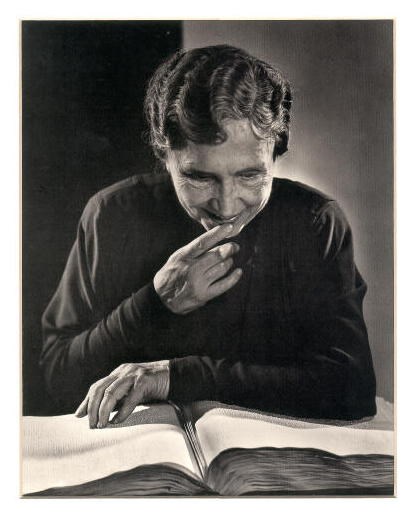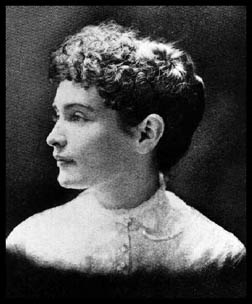 |
| Helen Keller |
Helen Adams Keller was born on June 27, 1880 in a tiny town called Tuscumbia, Alabama. She was the daughter of Captain Arthur Henley Keller and Kate Adams Keller, and was born happy and healthy, with no hearing or seeing problems.
On one bright day in February of 1882, Helen Keller was 19 months old when she fell seriously ill with a sickness that we even today do not know yet. Modern doctors think it was scarlet fever or meningitis. Whatever the illness was, it raged on for several days, and everybody thought that Helen would die. Fortunately, one day, the fever subsided and Helen’s family was as happy as ever.
However, Helen’s mother, Kate, soon realized that her daughter did not respond to the bell for dinner or when she waved her arms in front of her. It then hit everybody that Helen was blind and deaf.
During her childhood, Helen screamed and kicked like a monster all day. However, Helen had invented over sixty signs to communicate with her family, such as “I want to eat.” She was still very wild, however, so Helen’s mother decided to seek help. Therefore, she contacted the famous Alexander Graham Bell for advice.
Mr. Bell suggested that Kate write to the director of the Perkins Institution and Massachusetts Asylum for the Blind for a teacher. The director, Mr. Anagnos, immediately suggested Anne Mansfield Sullivan (nicknamed Annie), a former pupil of the institution.
Ms. Sullivan herself had lost a majority of her eyesight, as well, when she was about 5. She was searching desperately for a job, since it was hard to get a job for the nearly blind, when Mr. Anagnos called and asked her to teach Helen Keller. Of course, she accepted.

The first day Anne Sullivan arrived was a sweet and sour experience. Ms. Sullivan did not know that Helen always had terrible temper tantrums, until she came to their house. Therefore, she decided to stop them.
At the dinner table, before Ms. Sullivan had arrived, Helen was allowed to walk around and take food from anybody’s plate. When Ms. Sullivan came, Helen kept up the same routine. When she came to Anne’s table and almost got her hand into Ms. Sullivan’s food, she immediately slapped it. She tried repeatedly and soon had a tantrum. After an hour of fighting and slapping, Helen was finally forced to use her manners and sit down, eat with a fork, and fold her napkin.
While learning, Ms. Sullivan kept signing hand signals into Helen’s hand, but Helen did not know what they meant. However, on April 5, 1887 when Helen and Ms. Sullivan were walking outside, Ms. Sullivan found an opportunity to teach Helen. She took Helen to a pump, and pumped water onto her hand. Then she signed the word w-a-t-e-r into Helen’s hand. That suddenly made her understand what Ms. Sullivan had been doing all along on her hand. That day, she learned about 30 other words including teacher, mother, father, and sister.
After this event, Helen’s progress for learning words and such grew at an astonishing rate. Her ability was far advanced compared to anything that anybody had seen before in someone without sight or hearing. It was not long until Ms. Sullivan taught Helen to read both raised ordinary letters and Braille. Helen was also taught to write on both normal and Braille typewriters at about the same time.
One day in 1888, when Helen was just eight years old, Helen went to study at Perkins Institution for the Blind. She really enjoyed the Perkins Library, for they had the largest collection of Braille books in the United States. Helen pounced upon the books and sent her fingers flying over the dotted pages.
By the time it was summer and Perkins Institution had closed, Helen was already becoming famous. One newspaper called her “the wonder girl.” Another called Helen “a miracle.” Helen and Anne could now communicate with one another at top speed. Helen could spell eight words per minute into Anne’s hands. Anne was actually the only teacher who was able to keep up with her.
In 1894, Helen Keller and Anne Sullivan moved to New York City and went to the Wright-Humanson School. There, she studied arithmetic, geography, French, and German. While geography and German were her favorite classes, arithmetic bored her. During her stay, Helen met many new friends, including John D. Rockefeller and Andrew Carnegie, who were two of the richest men of the time, and Samuel Clemens (Mark Twain), the author who wrote The Adventures of Tom Sawyer. Helen would always be close friends with Mark Twain.

While Helen was still at the Wright-Humanson School, she received the news that her father, Arthur Henley Keller, had died. Helen was heartbroken. However, her father’s death made Helen decide that, in the years ahead, she wanted to go to “regular” college. Helen’s choice was Radcliffe College, which was a women’s college. Before she would be accepted to Radcliffe, Helen would have to pass the entrance exam. So, Helen entered the Cambridge School for Young Ladies to prepare. There, her sister Mildred also joined with her as a student in Cambridge.
After two years at Cambridge, Helen decided that she was ready to take the entrance exam to Radcliffe. She passed and entered Radcliffe in the fall of 1900. Entering Radcliffe, Helen would be the first deaf-blind student to ever attend an American college.
At Radcliffe College, she was treated the same way as all other students. She attended regular classes, and typed her papers on a regular typewriter. She also took swimming lessons and went to the gym. The only thing that made Helen Keller different was that Anne was by her side most of the time.
Since there were few Braille books at Radcliffe, the books that Helen was assigned to read had to be spelled letter by letter into Helen’s palm. Anne also had to spell what the teacher said in lectures. It was a problem when the teacher spoke too rapidly.

In 1904, Helen Keller graduated from Radcliffe College with the words cum laude added to her diploma, meaning “with honors.” Just like she was the first deaf-blind student to attend an American college, she was also the first to graduate.
When Helen was 25, Anne Sullivan and John Macy got married. Helen was the one that decided it, for Anne didn’t want anyone to come between her and Helen. However, when John signaled to Helen saying that Anne loved him and John loved her, Helen replied, “Then marry her, of course.”
In 1913, Helen had her first lecture with an audience in Montclair, New Jersey, in 1913. She was so nervous that first lecture that she burst into tears on the stage. Helen thought she had totally wrecked the lecture she gave, but the audience loved her performance. Helen Keller soon became one of America’s most popular speakers. Her lecture, called “The Heart and the Hand in the Right Use of Our Senses,” was so successful that Helen traveled to the West Coast in 1914 to do the lecture again. In 1915, she repeated the tour, and went to many places, such as the Midwest, Ohio, Indiana, Iowa, Kansas, St. Louis, Texas, Southern California, and up to San Francisco. In preparing for the long trip, Helen and Anne hired an assistant, who was 24 years old, named Polly Thomson.
On October 15, 1936, Anne Sullivan died. That night Helen was alongside her bed, holding her hand. Helen was extremely sad, since Helen and Anne had been companions for about fifty years. After Anne’s death, Polly would be her companion and the one always at her side.

Helen Keller had 32 more years of living, and she spent it wisely. She helped the Japanese raise money for people who were blind and deaf, and visited soldiers who were wounded or blinded during World War II. She was also awarded the Sacred Treasure Award from Japan, the Legion of Honor from France, Brazil’s Southern Cross, and the Philippines’ Golden Heart. Helen Keller had also met every single president who was in office from Grover Cleveland to John F. Kennedy.
However, late in 1958, Helen became sad again. Polly Thomson had turned seriously ill. Finally in 1960, Polly Thomson died at the age of 76. She had also been with Helen for more than half of her life. After Polly’s death, Helen soon found Winnie Corbally, who had nursed Polly, to be her new companion.
Soon after she met Patty Duke, who starred in The Miracle Worker as Helen, Helen Keller became frail and week. However in 1964, Helen received a special award from President Lyndon Johnson. She was awarded the Presidential Medal of Freedom, which is the nation’s highest honor.
Four years later, after she had received the Presidential Medal of Freedom in May, Helen suffered a heart attack. A few days later, on June 1, 1968, Helen Keller died. Winnie Corbally was at her bedside, just like Helen was at Anne's bedside when she died.
Helen’s ashes were taken to the National Cathedral in Washington. The ashes were placed next to the ashes of Anne Sullivan and Polly Thomson, her two most important companions.
Although Helen Keller died more than 40 years ago, people today still remember her as a wonderful person. Many things commemorate her life, including the movie, The Miracle Worker, which won two Academy Awards. In June, thousands of people go to Tuscumbia, where Helen was born. They are there to honor Helen Keller’s life and work. In 1999, Helen was even one of Time magazine's One Hundred most Influential People of the Century. Helen Keller was truly an amazing person, and we will remember her forever.
Page created on 1/23/2006 12:00:00 AM
Last edited 4/6/2024 6:50:43 PM
